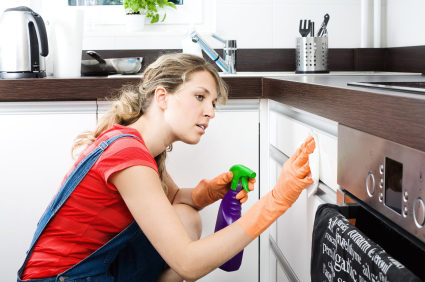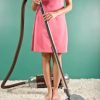There is nothing more frightening than a child making his or her way into your household cleaning supplies. It’s a parent’s worse nightmare! To this end, it is important to find alternative ways to clean a home without jeopardizing the health of your children or your family. We are all trying to become more environmentally aware of the dangers of toxins, not only in our home but as it relates to polluting our air, waters, and landscape.
Are your household cleaners safe? If not, here are some measures you can take to make your home a healthier one.
Vinegar, Lemon Juice, Olive Oil, Salt, and Baking Soda are all the ingredients you can use to clean your entire home. They are safe, non-toxic, and can do just as good a job as your more toxic household cleaners.
Let’s begin with windows. Instead of using a popular brand of glass cleaner, use water with vinegar and lemon juice to spray onto your windows. Vinegar can also be used to clean surfaces in your kitchen and bathroom; just add salt and water. If the oven needs to be cleaned, use liquid soap, Borax and warm water. Borax can also be used as a disinfectant in hot water as well as for cleaning toilets.
Polish your furniture with olive oil and lemon juice. You can also use lemon juice to polish copper kettles; just add a bit of salt. For use in the bathroom, use baking soda and warm water. This can also be used to unclog the drain by pouring the baking soda down the drain with a cup of vinegar.
At a time when pollutants are contributing to the depletion of the ozone layer; while gas and oil fumes are literally killing our natural resources; it is time to take a hard look at what we can do as individuals to decrease the toxins from our air and water. Perhaps if we begin to use alternative methods to using brand named household cleaners, we can send a clear and definitive message to these companies that toxins are no longer an acceptable form to be used in any capacity. It all begins with our taking a stand; it all begins at home.
Super Safe Tub Scrub:
Add one tablespoon of liquid soap and several drops of antibacterial essential oil (such as peppermint) to one cup of baking soda. Add just enough water to form a paste and use it with a sponge or brush to scour your tub.
Check out our Green Cleaning Guide…you can have it FREE when you subscribe to our blog feed (see right).



Aye, that is a big concern for us. We stick with the simpler things like you mention. Our worst ones are bleach and laundry detergent. The bleach is in a bottle with a child safe cap and then kept up on a very high shelf and we talk about how bad it is to them from a young age teaching them safe handling. For the laundry detergent we buy that in a 5 gallon pail (lasts a year or two) with a snap on lid that children can’t open. Heck, it’s hard for adults to open. Then a small amount is measured out and put in a container when we go in town to do laundry.
Pingback: The Parenting Buzz on Clipgator : ClipGator.com
It’s not just the household cleaners: Our shampoos, conditioners, hair products, hand soaps, laundry and softeners as well as deodorizers predominantly consist of petrol-chemicals along with some nasty poisonous aldehydes including formaldehyde. I was shocked when my newborn grandaughter was washed in the hospital with Johnson’s baby shampoo which is loaded with petroleum products and formaldehyde. — And let’s not forget about fragrance. Many scientific articles point out that 100% of commercial fragrance is 96% petroleum plus aldehyde with little to nothing to do with flowers and spices. What’s more it’s supposed to “gas
off” – leaving in its wake a plume of toxic gas for all of us – ugh – to share. The next time you’re going out on the town – spare all of us – and don’t wear the “eau de gasoline”!
Yes Elizabeth…cleaners are just one concern among many. BTW I love the eau de gasoline line!
One thing to keep in mind, though… baking soda can be toxic to young children if they consume too much – a condition known as baking soda poisoning. So you want to keep it out of their reach.
It seems as if no one is aware of the toxicity of Borax. Just as EDTA is something to look out for in EVERY product, one should look for Borax as well, since it is the primary cleaning agent in nearly all liquid detergents. When absorbed into the skin it attacks the central nervous system, for this reason the use it as the active ingredient in Torro (the ant killer), which most of us know is VERY effective. I find it disturbing that on most of our laundry detergent warning labels it says very clearly “Do not allow contact with skin or clothing” We’re washing our clothes with this stuff when it says not to, again, very disturbing.
It is very simple to make your own washing detergent. Just grind or shred a bar of natural soap and boil in a pot of water until dissolved. At that point you add it to roughly three gallons of water with about a cup of baking or washing soda and let sit for 24 hours. All you have to do is shake or stir before using and it cleans better than any detergent I have ever used.
-The quote from above is from SA8 premium with BioQuest laundry detergent. I contacted them about this, but of course I haven’t received a response.